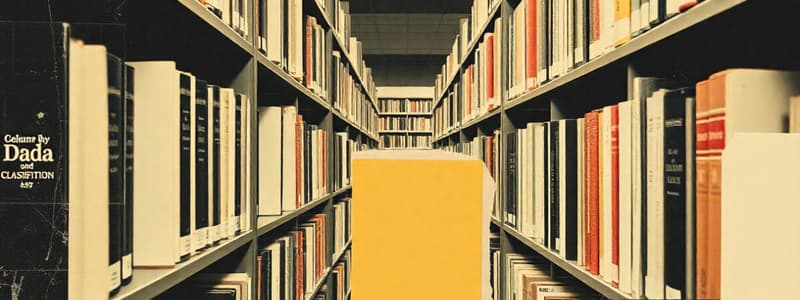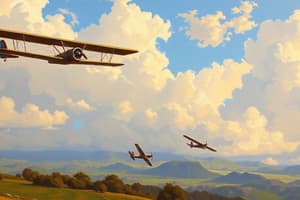Podcast
Questions and Answers
Which of the following represents a more specific subject than 'Agriculture and related technologies'?
Which of the following represents a more specific subject than 'Agriculture and related technologies'?
- Social sciences
- Animal husbandry (correct)
- Higher education
- Technology
The notation for a subject becomes more specific with the addition of digits after the decimal point.
The notation for a subject becomes more specific with the addition of digits after the decimal point.
True (A)
What is the class number for a book titled 'Chemistry'?
What is the class number for a book titled 'Chemistry'?
540
The call number consists of the class number plus _______ of the author's name or title name.
The call number consists of the class number plus _______ of the author's name or title name.
Match the following subjects with their corresponding class numbers:
Match the following subjects with their corresponding class numbers:
What is the main purpose of classification?
What is the main purpose of classification?
The Dewey Decimal Classification scheme includes 10 main classes, all of which are numerical.
The Dewey Decimal Classification scheme includes 10 main classes, all of which are numerical.
Name one classification scheme besides the Dewey Decimal Classification.
Name one classification scheme besides the Dewey Decimal Classification.
The classification system that organizes library materials according to subject content is known as _______.
The classification system that organizes library materials according to subject content is known as _______.
Match the following main classes from the Dewey Decimal Classification to their respective subject areas:
Match the following main classes from the Dewey Decimal Classification to their respective subject areas:
Who is the author of the book titled 'Chemistry'?
Who is the author of the book titled 'Chemistry'?
Which of the following is NOT a main class in the Dewey Decimal Classification?
Which of the following is NOT a main class in the Dewey Decimal Classification?
The call number for 'Introduction to Economics' is 330 DLU.
The call number for 'Introduction to Economics' is 330 DLU.
Classification schemes are only used in libraries.
Classification schemes are only used in libraries.
What is the call number for the video tape titled 'Umbhacanga'?
What is the call number for the video tape titled 'Umbhacanga'?
How many subclasses does the Mathematics class (510) have?
How many subclasses does the Mathematics class (510) have?
Books should be arranged on the shelves from left to right by the _______ number.
Books should be arranged on the shelves from left to right by the _______ number.
Match the prefixes with their corresponding information formats:
Match the prefixes with their corresponding information formats:
Which call number corresponds to the book 'Applied Mathematics'?
Which call number corresponds to the book 'Applied Mathematics'?
It is recommended to shelve books with spines facing the back of the shelf.
It is recommended to shelve books with spines facing the back of the shelf.
The call number 910 ZUL belongs to a book on _______.
The call number 910 ZUL belongs to a book on _______.
Flashcards
What is classification?
What is classification?
Arranging things in a particular order or into categories based on their similarities.
What is library classification?
What is library classification?
The practice of grouping information materials of the same subject together in a library.
Explain the hierarchical nature of classification.
Explain the hierarchical nature of classification.
The process of categorizing knowledge into a hierarchical structure, starting with broad categories and becoming more specific.
Describe the Dewey Decimal Classification (DDC).
Describe the Dewey Decimal Classification (DDC).
Signup and view all the flashcards
What are the 10 main classes in the Dewey Decimal Classification?
What are the 10 main classes in the Dewey Decimal Classification?
Signup and view all the flashcards
Explain how the Dewey Decimal Classification subdivides each main class.
Explain how the Dewey Decimal Classification subdivides each main class.
Signup and view all the flashcards
Why is the Dewey Decimal Classification useful?
Why is the Dewey Decimal Classification useful?
Signup and view all the flashcards
What are the benefits of using a classification system like the Dewey Decimal Classification?
What are the benefits of using a classification system like the Dewey Decimal Classification?
Signup and view all the flashcards
Specificity in DDC
Specificity in DDC
Signup and view all the flashcards
Hierarchy in DDC
Hierarchy in DDC
Signup and view all the flashcards
DDC - Subordinate Concepts
DDC - Subordinate Concepts
Signup and view all the flashcards
DDC - Notations
DDC - Notations
Signup and view all the flashcards
Call Number
Call Number
Signup and view all the flashcards
Call Number System
Call Number System
Signup and view all the flashcards
DDC Number
DDC Number
Signup and view all the flashcards
Author/Title Code
Author/Title Code
Signup and view all the flashcards
Format Prefix
Format Prefix
Signup and view all the flashcards
Shelving Order
Shelving Order
Signup and view all the flashcards
Subject Collection
Subject Collection
Signup and view all the flashcards
Spine Facing Outwards
Spine Facing Outwards
Signup and view all the flashcards
Shelving
Shelving
Signup and view all the flashcards
Study Notes
Classification Overview
- Classification is the arrangement of items into categories or a particular order
- It's used to group items based on similarities
- Classification is used in various settings, including grocery stores and libraries.
- Libraries classify materials according to subject content, placing items of the same subject together (co-location).
- Classification facilitates organization, location, identification, and retrieval of information.
Why Classify Items?
- Aids users in easily finding needed information
- Makes collections easier to browse
- Enables subject access
Types of Classification Schemes
- Library of Congress (LC): Developed by the Library of Congress for classifying materials in their collection.
- Dewey Decimal Classification (DDC): A numerical system for arranging library materials by subject. Developed by Melville Dewey in 1876 and updated several times. Dividing knowledge into 10 broad classes.
Dewey Decimal Classification (DDC) Details
- DDC divides human knowledge into 10 main classes
- Each main class has further subdivisions (e.g., 500-599 is Science)
- The specificity of the class is indicated by adding more digits (e.g., 510.7; 510.712)
Hierarchy in DDC
- The hierarchy of DDC is expressed through the notation
- The length of the notation indicates the hierarchy (e.g., "Dogs" and "Cats" are subordinate to "Animal husbandry").
- A hierarchical structure from general to more specific information is illustrated (showing social sciences, education and higher education).
Example Classifications
- A chemistry book written by Sipho Dlamini: 540 DLA
- A physics book written by Nokwethu Khumalo: 530 KHU
- A history of Africa edited by Ziyanda Nxumalo: 960 HIS
- An introduction to library and information science: 020 INT
Call Number Structure
- A call number uniquely identifies a book for shelving
- Contains a class number and usually 3 initial letters of the author's name or title (e.g., 540 DLA)
- The use of prefixes denotes different formats (e.g., a journal, article, government document, thesis etc)
Shelving Tips
- Books should be placed with their spines facing the front edge of the shelf
- Books should be arranged by call number (numerical and alphabetical order) left to right
- Adequate space should be provided for shelving to avoid damage.
- Shelves should ideally be adjustable to accommodate various book sizes
- Current magazines and new arrivals should be displayed on separate shelves for quick access and easier visibility
Studying That Suits You
Use AI to generate personalized quizzes and flashcards to suit your learning preferences.




